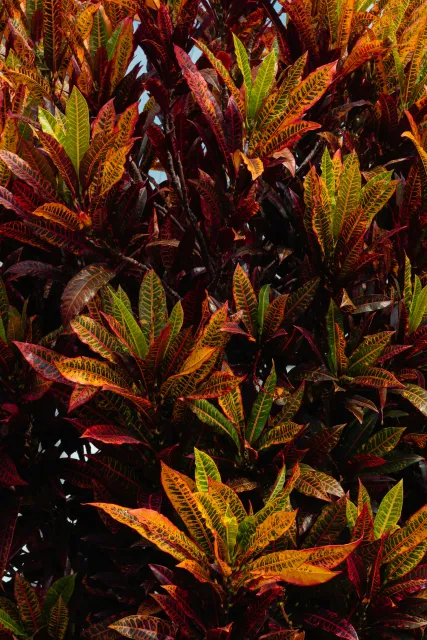Blog by Michelle Krespi
My husband, who has always been a plant lover, came home the other day with a Codiaeum variegatum. They are commonly referred to as Variegated Croton, Garden Croton, or Fire Croton. These are broad-leafed evergreen tropical shrubs that can grow up to 10’ tall in the wild and as a houseplant, from 3’ to 8’ tall. They grow in an upright form. I recently learned that you can’t always depend on what you read to give you accurate info on things like the size of a plant, since so much depends on the environmental conditions that you provide for them. This underscores the benefits of reading about your plants to make sure all of their needs are being met.

For this plant, it’s important to get soil, lighting, and humidity conditions just right. In my zone 11B, they can be grown inside or out, but there is a definite temperature range. The ideal range is between 70°- 85° Fahrenheit. Above 80°F, you run the risk of dehydration and scorch. Below 59° you’re in the danger zone of chill damage. Keep your plant away from cold drafts and radiators. Crotons will tell you when they are unhappy with wilted or discolored leaves. I learned from experience putting a plastic hood over my floorboard heat/air conditioner vent to redirect the air away from my indoor plants. Another climate factor that really helps this plant is HUMIDITY! For this, you can use a humidifier or go basic and place pebbles in a saucer underneath your plant and fill the saucer with enough water, avoiding the roots or plant bottom touching the water.[1] They also love to be misted daily!
There are several hundred cultivars of this plant, and they are selected and bred for their foliage. The leaves in these cultivars are glabrous,[2] thick and leathery with smooth margins. The cultivars vary in size, shape, and range in color from yellow, orange, pink, red, and green, with very distinctive patterns. I even read in my research that some patterns have been described as tie-dyed!
Another distinctive feature is that when you break off a leaf, it produces a milky sap (which dries clear), depending on the variety, and has a latex consistency. It is advised to avoid contact with the sap since it is a skin irritant and toxic if ingested. It can also cause contact dermatitis. As far as the stems go, the grey color indicates old growth, while the stems of new growth are green.
My favorite part of plant care has always been propagation. These plants do best when propagated in spring or summer. While this croton can be rooted in water, the quickest and most efficient way to do it is by stem cuttings. Find a vigorous stem and make a diagonal cut 3” to 5” from the top of the stem using a sharp, sterilized blade. Make sure there are at least three leaves, and the cutting is 3 to 4” long. Once cut, let the cutting rest in a dry place (not in the sun) for 24 hours. The cut needs to scab over, leaving it less vulnerable to infection when planted in the soil. To accelerate the rooting, dip the end of the stem in rooting hormone powder, and once dry, plant it in a well-draining, humus-rich soil mixture. It is important to add things like vermiculite, perlite, and peat moss to keep the soil aerated. Since humidity is so important to this plant’s propagation success, you can cover the cuttings with a plastic bag to keep the humidity high until the plant is established. You’ll know when this has been accomplished because the cutting will no longer wobbly[3] in its soil mixture. It is important to keep misting your croton. Finally, all plants require fertilization, and crotons are no different. Use a balanced[4] water-soluble fertilizer. You can tell it’s balanced when the three numbers on the label are all the sam,e like 10-10-10.[5]
In providing this level of care, you will ensure a plant with lasting beauty for years to come!
[1] North Carolina Extension Gardener Plant Toolbox
[2]Definition of glabrous- smooth, having a surface without hairs or any unevenness.
[3] Website www.gardeningknowhow.com “How to Propagate a Croton Plant” & from the website Live to Plant “How to Propagate Codiaeum Plant the Right Way
[4] A balanced fertilizer means it contains equal parts of the three macronutrients N- nitrogen, P- phosphorus, K- potassium.
[5] www.epic-agriculture.com/blo/codiaeum-variegatum-care-guide-unlock-lush-colorful-growth/

